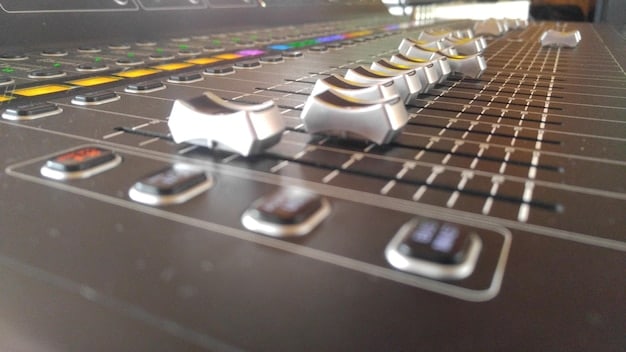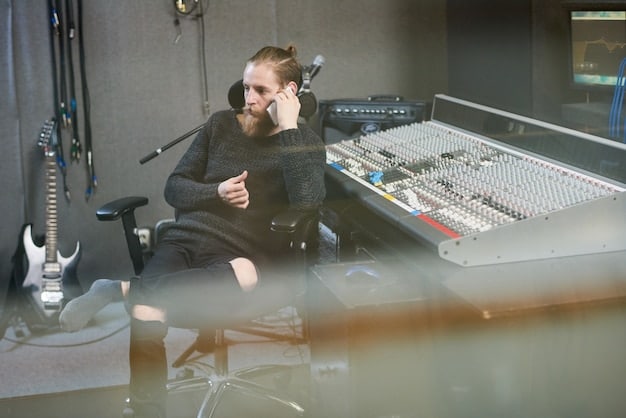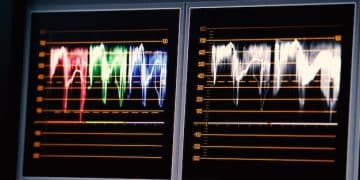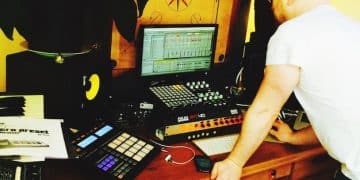Advanced Reverb Techniques: Mastering Depth and Space in Your Mix

Advanced reverb techniques are crucial for music producers aiming to manipulate perceived space and depth, employing methods like pre-delay adjustments, EQing reverb tails, and creative use of different reverb types to enhance a mix’s sonic landscape.
Creating immersive and professional-sounding mixes often hinges on your ability to manipulate space. Advanced reverb techniques are essential tools for adding depth, width, and character to your tracks, transforming them from flat and lifeless to captivating and dynamic.
Unlocking the Secrets of Advanced Reverb
Reverb, short for reverberation, simulates the reflections of sound in a physical space. Mastering reverb goes beyond simply adding the effect; it’s about shaping the characteristics of that simulated space to enhance the sonic landscape of your mix. By understanding and utilizing advanced techniques, you’ll gain greater control over how your sounds sit within the mix, adding clarity, depth, and emotional impact.
This guide will explore several advanced reverb techniques, providing you with the knowledge to create stunning spatial effects. Whether you’re aiming for a subtle ambience or a dramatic, otherworldly atmosphere, these techniques will empower you to elevate your music production skills.

Pre-Delay: Sculpting Clarity in Your Mix
Pre-delay is the time gap between the initial sound and the start of the reverb effect. It’s a powerful tool for preserving the clarity of the original sound while still adding the desired sense of space.
Using pre-delay effectively involves careful listening and understanding how it interacts with the other elements of your mix. Too little pre-delay, and the reverb can muddy the original sound. Too much, and the reverb might sound detached and unnatural.
Finding the Right Pre-Delay Time
The ideal pre-delay time often depends on the tempo of your song. A good starting point is to sync the pre-delay to a rhythmic division of the beat. For example, you could set the pre-delay to an eighth note or a quarter note. Experiment with different values to find what sounds best for your specific track.
Creative Pre-Delay Applications
Beyond rhythmic synchronization, pre-delay can be used creatively to create interesting sonic textures. Try using a longer pre-delay time to create a distinct echo effect before the reverb kicks in. This can be particularly effective on vocals or lead instruments.
- Preserves clarity: Allows the initial transient to stand out before the reverb envelops it.
- Creates separation: Gives the listener a clearer sense of the direct sound.
- Adds rhythmic interest: Can be synced to the tempo of the track for a pulsing effect.
Experimenting with pre-delay is crucial. Listen carefully to how it affects the perceived space and clarity of your mix. Don’t be afraid to push the boundaries and try unconventional settings to achieve unique and compelling results. The key is to fine-tune the pre-delay until it complements the original sound without overshadowing it.
EQing Reverb: Taming the Tail
EQing reverb, also known as equalization, is a crucial advanced reverb technique that shapes its tonal characteristics, preventing muddiness and allowing it to sit harmoniously within your mix. By carefully sculpting the frequencies of the reverb tail, you can create a sense of space without sacrificing clarity or overall balance.
By precisely cutting the low-end frequencies, you reduce unwanted rumble and build-up that can cloud the low frequencies, making the track sound muddy and unfocused. Simultaneously, taming the high-end frequencies ensures the reverb doesn’t become harsh or sibilant, contributing to a smoother, more polished sound.
Why EQ Your Reverb?
Reverb often interacts unexpectedly with the original sound, which may lead to unwanted resonances or frequency masking. EQing the reverb tail allows you to address these issues proactively, creating a cleaner and more defined mix. By targeting and attenuating specific frequencies within the reverb, you control its overall impact on the sonic landscape.
Practical EQ Techniques for Reverb
Start by applying a high-pass filter to remove any low-frequency content below 200-300 Hz. Then, sweep through the frequency spectrum to identify any problematic areas like harsh resonances or muddiness, which can be attenuated by narrow cuts. Enhance the reverb’s clarity by gently boosting the high frequencies (around 8-10 kHz) in moderation.
- Cleaning up Muddiness: Boost a low shelf filter to remove the rumble.
- Removing Harsh Frequencies: Use bell filters to target and reduce harsh resonances in the mid and high frequencies.
- Creating Air and Space: Gently shape the high frequencies to brighten it.
EQing your reverb tail serves as a subtle but vital tool in achieving a polished mix. By carefully sculpting the frequencies, you can create a greater sense of space while maintaining the clarity and definition of individual tracks and blend the overall sound into a cohesive experience.

Exploring Different Reverb Types
The world of reverb is vast, offering a wide array of sonic textures to explore. From the classic warmth of plate reverb to the immersive depth of convolution reverb, understanding the characteristics of each type is crucial for creating captivating soundscapes.
Selecting the right reverb type is not merely a technical choice; it’s an artistic one. Each type brings its own unique characteristics to the table, influencing the overall mood and atmosphere of the mix. Plate reverb excels at adding a smooth, vintage vibe and lends itself to enhancing vocals and drums with a touch of classic flair, while hall reverb creates a sense of grandeur, immersing instruments and vocals in the expansive sound dynamics of a grand concert hall.
Plate Reverb: The Vintage Charm
Plate reverb produces a dense and diffuse sound, delivering warmth and smoothness to any track. Crafted from a vibrating metal plate and transducers, it enhances the harmonic content, giving vocals and drums a luscious, vintage quality. Often used in pop, rock, and R&B genres, plate reverb offers a subtle depth and helps individual elements stand out in the mix with classic flair.
Hall Reverb: The Grandiose Ambience
Hall reverb captures the acoustic properties of great concert halls, where its expansive and immersive sound creates a sense of space and grandeur. Renowned for long decay times, this type of reverb allows instruments and vocals to resonate within a broad, enveloping soundscape. Hall reverb is perfect for creating a celestial effect, lending a dramatic touch to orchestral arrangements, ambient soundscapes, and soaring vocals.
Convolution Reverb: Capturing Reality
Convolution reverb uses recordings of real spaces, called impulse responses, to recreate authentic acoustic environments. This reverb type provides sound with precision, enabling producers to emulate real concert halls, rooms, or even unconventional soundscapes. Convolution reverb brings sound to life with a natural and realistic dimension, making it especially useful for film scoring, sound design, and creating hyper-realistic environment audio.
- Sonic Versatility: Different reverbs add distinct character to your mix.
- Emotional Impact: Adjusting the reverb can evoke different emotions in the listener.
- Textural Depth: Use a variety of reverbs to create a complex and layered soundscape.
Mastering the advanced reverb techniques can shape mixes from simply being heard to being fully experienced. By carefully manipulating the advanced reverb options, each track can be enriched with depth and space tailored to enhance the sonic experience.
Creating Depth with Reverb
Reverb is invaluable in creating a sense of depth within a mix and is essential for placing instruments in a three-dimensional soundscape. By carefully manipulating reverb parameters, you can control how far away each element appears to the listener.
By integrating techniques to manipulate the reverb, it subtly enhances the overall sound. In turn, it adds depth to music, giving it space, layers, and a more polished feel. These improvements make it more compelling and enjoyable to listen to. The use of reverb is essential if you want to create a high-quality sonic experience.
Short Reverbs for Intimacy
Using short reverb times positions sounds closer to the listener. Subtle room reverbs or tight ambience effects can bring vocals and instruments to the forefront. These short reverberations create a sense of immediacy and presence, making the listener feel more connected to the performance.
Long Reverbs for Distance
Longer reverb times create the illusion of distance. By placing instruments in larger spaces with extended decay times, you can push them further back in the mix. These longer reverbs add depth and spaciousness, making the soundstage feel more expansive and immersive.
Layering Reverbs for Complexity
Combining different reverb types and parameters can create complex and textured soundscapes. Try layering a short, bright reverb with a longer, darker reverb to create a sense of depth and dimension. Experiment with different combinations to find what works best for your specific mix.
Mastering depth creation involves artistry. This approach enhances a mix’s overall emotional impact and immersiveness, turning sound experiences into something deeply captivating. With these reverb-enhancing methods, music producers can create an amazing listening experience.
Using Reverb as an Effect
Though often used subtly to enhance the realism and cohesion of a mix, reverb can also be a powerful creative effect in its own right. By pushing the parameters of reverb to their extremes, you can create unique and otherworldly soundscapes that grab the listener’s attention.
Creative use of reverb opens up immense possibilities for music production, taking individual tracks beyond their usual sonic boundaries allowing for an unparalleled sonic adventure. Experimenting with gated reverb on drums can create edgy, impactful soundscapes, while modulating the reverb tail induces a dynamic sense of motion to add layers of depth and character to sounds.
Gated Reverb: The Retro Vibe
Gated reverb, popularized in the 1980s, abruptly cuts off the reverb tail, creating a distinctive and punchy sound. This effect works wonders on drums, adding snap and impact. Experiment with different gate settings to fine-tune the length and intensity of the effect.
Modulated Reverb: Adding Movement
Modulating the reverb tail can create a sense of movement and instability. By using an LFO (Low-Frequency Oscillator) to modulate parameters like decay time or diffusion, you can add subtle or dramatic variations to the reverb effect. This technique can be used to create swirling, ethereal textures.
- Creating Unique Textures: Extreme reverb settings can push your sounds into new territory.
- Adding Excitement: Using reverb as an effect can inject energy into your tracks.
- Experimentation is Key: Don’t be afraid to try unconventional settings and combinations.
Pushing the boundaries of reverb opens up a realm of possibilities for innovative sound design. By intentionally manipulating and experimenting with reverb, music producers can add unique sonic colors to their mix, creating a signature sound for their art.
Reverb and the Mix Bus
Applying reverb to the mix bus, also known as global reverb, can help glue your mix together creating a sense of cohesion and unity. By sending elements of your mix to a shared reverb space, you can create a more natural and believable sonic environment.
A unifying sense of direction is vital when adding a global reverb effect. If done well, the added reverb can knit all the elements together, creating a cohesive piece of music. This approach wraps individual sounds in the same acoustic environment, creating an immersive experience for the listener. However, overuse can lead to a very muddy mix, masking subtle details and robbing the song of its dynamic range. Careful execution is essential for creating that much-desired polish and connection.
Subtle Global Reverb
Start with a subtle reverb setting, such as a small room or a short plate. Aim for a decay time of less than one second and adjust the send levels of each channel to taste. The goal is to create a sense of space without overpowering the individual elements of the mix.
EQ Considerations
When using global reverb, pay close attention to the frequency balance. Use EQ to clean up any muddiness or harshness in the reverb return. A high-pass filter can be particularly useful for removing low-frequency build-up.
- Creating Cohesion: Global reverb can help blend the elements of your mix.
- Adding Depth: A subtle global reverb can enhance the sense of space.
- Careful Balancing: Avoid overusing global reverb, as it can compromise clarity.
When skillfully applied, global reverb improves overall mix coherence, drawing listeners more deeply into a comprehensive sonic experience. Approached with sensitivity and precision, it elevates the work from a simple combination of sounds to an immersive musical encounter.
| Key Point | Brief Description |
|---|---|
| ⏱️ Pre-Delay | Controls the time gap between the original sound and the start of the reverb, enhancing clarity. |
| 🎵 EQing Reverb | Shapes the tonal characteristics of reverb, preventing muddiness and integrating reverb harmoniously. |
| 🔊 Reverb Types | Different reverb types (plate, hall, convolution) offer unique sonic textures for creating varied soundscapes. |
| 🎚️ Mix Bus Reverb | Applying reverb to the mix bus helps glue the mix together, creating cohesion and unity. |
Frequently Asked Questions
▼
Pre-delay is a short delay before the reverb effect starts. It helps to separate the original sound from the reverb, maintaining clarity and adding rhythmic interest depending on the tempo.
▼
EQ for reverb shapes its tone and prevents muddiness. By cutting low and high frequencies, it ensures reverb doesn’t overpower the mix. This creates a cleaner, more defined sound.
▼
Common reverb types include plate, hall, and convolution. Plate adds warmth, hall creates grand space, and convolution recreates real acoustic environments, ensuring each track is enriched with specific depths.
▼
Using short reverbs brings sounds closer, while longer reverbs create distance. Layering different types enhances texture. This creates sonic richness, adding layers for a more polished mix.
▼
Global reverb is reverb applied to the entire mix, creating a cohesive sonic environment. Subtle use integrates all elements, producing an inclusive and immersive musical experience for the listener.
Conclusion
By mastering advanced reverb techniques, music producers can unlock new dimensions of depth, space, and emotion in their mixes. Experiment with different reverb types, pre-delay settings, EQ techniques, and creative effects to discover the sonic possibilities that await. Remember, the key is to listen carefully and trust your ears as you sculpt the perfect reverb soundscapes for your music.





